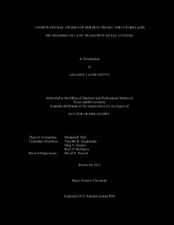| dc.contributor.advisor | Hall, Michael B | |
| dc.creator | Pitts, Amanda | |
| dc.date.accessioned | 2014-05-13T17:09:06Z | |
| dc.date.available | 2015-12-01T06:31:17Z | |
| dc.date.created | 2013-12 | |
| dc.date.issued | 2013-08-27 | |
| dc.date.submitted | December 2013 | |
| dc.identifier.uri | https://hdl.handle.net/1969.1/151653 | |
| dc.description.abstract | Late transition metal species are heavily studied because of their diverse applications in industrial, synthetic, and biological processes. Transition metals can alter the thermodynamic aspects of a reaction by creating an alternative, lower-energy pathway, which is not accessible without a metal. Numerous investigations have been performed to better understand the elementary steps within these reactions. The significant increase in available computing power coupled with the further development of transition-metal friendly quantum chemical methods has assisted in making computational chemistry an important method in predicting transition-metal mechanisms. This dissertation is divided into four parts, one for each of the transition-metal systems that were studied.
The first system focuses on the formation of a carbon-bromine bond from the reaction of Ni(Ar)(Br)(pic) (Ar = 2-phenylpyridine, pic = 2-picoloine) with Br2. Unlike the typical behavior of heavier group 10 metals that have a wider range of stable oxidation states, Ni was found to undergo a change multiplicity during this reaction. The mechanism proceeds through a triplet state pathway that is stabilized by a Br2-/NiIII interaction instead of the NiIV singlet state pathway. The second two systems are concerned with inter- and intramolecular carbon-hydrogen bond activation, respectively. In the second system the lifetimes of carbon-hydrogen activation of four cycloalkanes with the Cp’Rh(CO) fragments (Cp’= η5-C5H5 or η5-C5Me5) were calculated. The lifetimes were found to be dependent of the size of the cycloalkane reacting and the number of possible reaction paths associated with the specific cycloalkane. A intramolecular carbon-hydrogen bond activation mechanism was calculated for the RuII(SC6H3Me2-2,6-κ1S)2(PMe3)3 species for the third system. The dominant pathway was predicted to be the equatorial mechanism which proceeds through a σ-bond metathesis reaction. The final transition-metal system involves the transfer of CuI from the Atox1 metal binding site to a metal binding domain on the ATP7A or ATP7B proteins. This system was found to proceed through a dissociative pathway wich each two-coordinate and three-coordinate species stabilized by adopting the optimized the S lone pair/Cu 3d π-overlap. | en |
| dc.format.mimetype | application/pdf | |
| dc.language.iso | en | |
| dc.subject | Computational Chemistry | en |
| dc.subject | Inorganic Chemistry | en |
| dc.subject | Density Functional Theory | en |
| dc.title | Computational Studies of the Electronic Structures and Mechanisms of Late Transition Metal Systems | en |
| dc.type | Thesis | en |
| thesis.degree.department | Chemistry | en |
| thesis.degree.discipline | Chemistry | en |
| thesis.degree.grantor | Texas A & M University | en |
| thesis.degree.name | Doctor of Philosophy | en |
| thesis.degree.level | Doctoral | en |
| dc.contributor.committeeMember | Hughbanks, Timothy R | |
| dc.contributor.committeeMember | Ozerov, Oleg V | |
| dc.contributor.committeeMember | Balbuena, Perla B | |
| dc.type.material | text | en |
| dc.date.updated | 2014-05-13T17:09:06Z | |
| local.embargo.terms | 2015-12-01 | |


